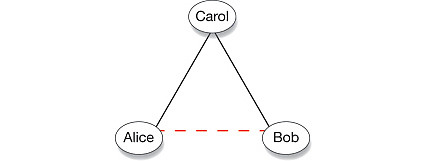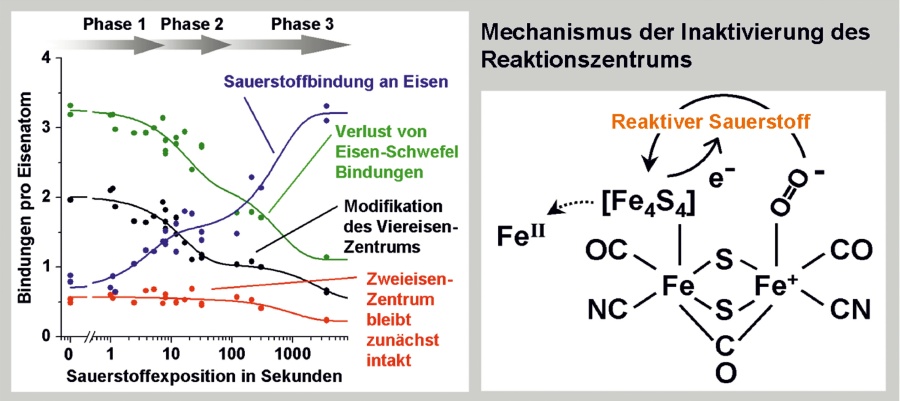Since physicists love Alice and Bob, we can make a psychological dissonance graphic also by introducing a third character, Carol. If the solid lines are positive and dashes are negative, there is equilibrium as long as everyone is an enemy or everyone is a friend. It is where there is one enemy that games of "Risk" really get played.

Positive lines are friendly, dashed are negative. If Carol is friends with Alice and Bob and Alice and Bob become enemies, things get weird. Complex interpersonal relationship graphic courtesy of: NY Times
Just because someone is the enemy of your enemy does not make them your friend, they could still be trying to bring you down. (1) They are a 'frenemy', that colloquial portmanteau of friend and enemy, and it could also be someone who seems to be a friend but really is not.
This happens even at the basest levels of biology, it seems, even in proteins. Hydrogenases are used for the production of hydrogen but they are sensitive to oxygen and oxygen is the biggest potential frenemy of all. It's obviously essential to life but too much of it will kill off the cast of Grey's Anatomy.(2)
In enzymes like hydrogenases, catalysts that convert electrons and protons to hydrogen, navigating the frenemy status is essential. FeFe - di-iron - hydrogenases can produce large amounts of hydrogen. so using X-ray absorption spectroscopy, researchers at Ruhr-Universität Bochum found that the generation of hydrogen, which takes place at the H-cluster consisting of the di-iron and four-iron sub-cluster which help form the reactive core, occurs because oxygen binds to the di-iron center of the hydrogenase, which makes the four further iron atoms inactive.

Oxygen inactivates the hydrogenase in three phases. The longer the enzyme is exposed to oxygen, the greater the number of oxygen particles that bind to the iron atoms of the hydrogenase (blue), which leads to a reduction in the number of bonds between the iron atoms and other atoms (green, black). The right-hand section of the illustration shows the hypothetical mechanism of the inactivation. Oxygen (O=O) binds to the di-iron center which leads to the development of an aggressive oxygen species. This attacks the four-iron center [4Fe4S], which suppresses its ability to generate hydrogen. Credit: RUB
They were able to discover this by using the Swiss Light Source synchroton in Switzerland (not everything happens at the LHC, you know) to visualize the metal centers in proteins. Doing so, they were able to 'break down' the reaction into its separate phases. First, they brought the hydrogenase sample into contact with oxygen for a few seconds then for a few hours and finally they deep froze it in liquid nitrogen.
The oxygen molecule binds to the di-iron center of the hydrogenase, which leads to the development of what they call 'an aggressive oxygen species' which then attacks and modifies the four-iron center.
“The velocity of the entire process is possibly dependent on the phase during which the aggressive oxygen species moves from the di-iron to the four-iron center. We are currently elaborating further experiments to investigate this,” said Camilla Lambertz from the Ruhr-Universität Bochumstudy group for photobiotechnology.
So even at the protein level it makes sense to keep a friend like oxygen close, but not let him take over the place.
Citation: C. Lambertz, N. Leidel, K.G.V. Havelius, J. Noth, P. Chernev, M. Winkler, T. Happe, M. Haumann (2011) O2-reactions at the six-iron active site (H-cluster) in [FeFe]-hydrogenase, Journal of Biological Chemistry, doi: 10.1074/jbc.M111.283648
NOTES:
(1) In World War II Stalin was the frenemy of everyone at one point or another. He was pals with Hitler and then became pals with the Allies. He wanted the US to invade Europe right away so more westerners would get killed and he could slide into Europe, while Britain and the US wanted Germany and the USSR to kill each other as much as possible first, knowing neither Soviet communism nor National socialism were ever going to be good for democracy.
(2) No, really. They are so desperate for plotlines oxygen is the enemy in an upcoming episode:





Comments